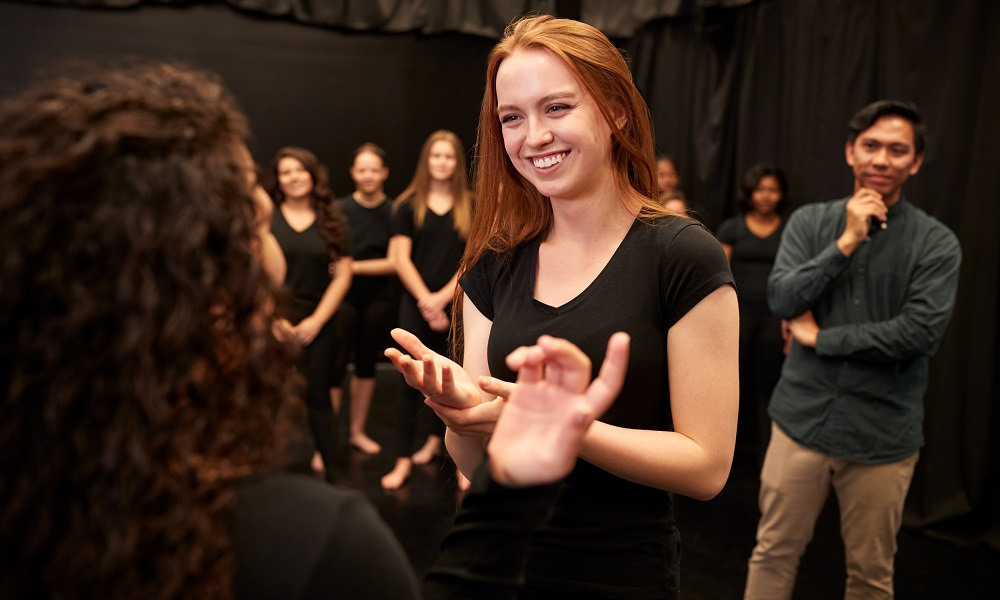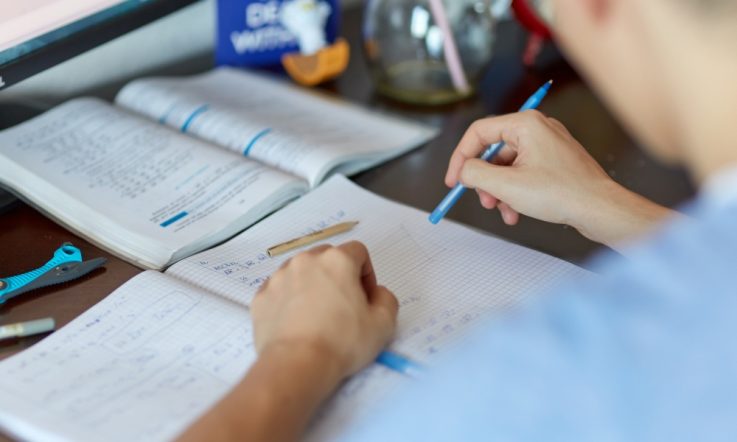Samantha Marsden's new book, 100 Acting Exercises for 8-18 year olds, shares classroom exercises aimed at unleashing the inner creativity of students. In this extract for Teacher readers – taken from a chapter on unblocking performers – Marsden discusses the importance of drama teachers creating a safe space for students to build their confidence and share their ideas. She also offers four practical exercises that allow students to shine in front of their classmates.
Part of the actor's training is to learn how to respond to creative intuition without being afraid of what others think. While teaching children and young people, one of the biggest obstacles to creativity is that too many youngsters are afraid to shine in front of their classmates. This can be for a number of reasons, but it's the drama teacher's job to create a safe space where students have the confidence to shine and be their true selves. There's some advice in the introduction on how to create a safe space.
In this chapter I provide exercises that are fun, simple and good for building improvisation skills and confidence. In order to unblock students, it's important that neither the teacher nor anyone else in the group is negative about any idea or improvisation. All ideas should be praised (unless the idea causes another student harm). The drama group should be trained by the teacher to praise each other, to accept all ideas and to fully go with any suggestion.
The unblocked actor can perform from the subconscious and listen to their intuition; this is what all actors should be aiming for. Improvisation is one of the best practices for obtaining this state; therefore, this chapter is made up of 100 per cent improvisation exercises.
Exercise 1: Pass the face
A simple warm-up game where students look at one another as they pass a facial expression around the circle.
Age: 8 plus.
Skills: Communicative skills, imagination, confidence and improvisation.
Participants: A group of five or more.
Time: 5–10 minutes.
You'll need: A group of students to sit in a circle.
How to: Ask students to sit in a circle and explain that a facial expression is going to be passed around the circle. This can be any expression: sad, happy, worried, afraid, excited or any other feeling that the teacher or group can think of. Let's start with excited. One student will start: they give an excited look to the person sitting next to them. The person they are sitting next to will then fill with excitement and pass the excited look to the next person in the circle. The excited look gets passed around the circle until everyone has received and passed on the excited look.
Tip: Ask students to make eye contact with the person they are passing the face to.
The aim: For students to become comfortable with expressing an emotion and then showing this.
Exercise 2: Honey, I love you
A fun warm-up game where students are not allowed to smile when someone approaches them and says in a humorous way, ‘Honey, I love you.'
Age: 8 plus.
Skills: Communicative skills, imagination, confidence, self-control, group awareness and improvisation.
Participants: A group of five or more.
Time: 10–15 minutes.
You'll need: A group of students to stand in a circle.
How to: Students stand in a circle, and one student volunteers and stands in the centre; let's call her Carolina. Carolina approaches one person in the circle and says, ‘Honey, I love you!' It's Carolina's aim to make this person laugh, so she may say this in a funny way, perhaps by getting down on one knee and saying it in a silly voice or she may do a funny little dance. The person she says ‘Honey, I love you!' to – let's call her Eden – is not allowed to smile and, with a completely straight face, she has to reply with ‘Honey, I love you too, but I just can't smile.' If Eden smiles, she needs to go into the centre of the circle and take Carolina's place and Carolina stands in the circle, while Eden chooses a new person to say ‘Honey, I love you!'. However, if Eden manages to keep a straight face, Carolina stays where she is in the circle and has to find someone else to say ‘Honey, I love you!'.
Tip: Ask students not to make physical contact in this exercise as it has the potential to go too far in this exercise.
The aim: To loosen students up and encourage.
Exercise 3: Sausages
A fun game where students have to practise not smiling – perfect for a warm-up or cool-down.
Age: 8 plus.
Skills: Listening, communicative skills, self-control and focus.
Participants: This exercise can be practised with two participants, but five or more are preferable.
Time: 5–15 minutes.
You'll need: A chair centre stage and for the students to sit in front of this like an audience.
How to: The teacher asks everybody to sit as an audience facing one chair that is set centre stage. A volunteer will sit on that chair. When sitting on the chair, you are not allowed to smile or cover your face. The aim is to keep a neutral expression while sitting on the chair. Members of the audience put up their hands to ask a question, and the student on the chair will point to the person who is to ask the question. The questions can be anything: ‘What's your favourite food?', ‘What is your favourite book?' or ‘What do you brush your teeth with?' The only answer the person on the chair is allowed to give is ‘sausages'. And they must keep a straight face. If the person on the chair smiles or laughs, then they come off the chair and the person who asked the question that made them break sits on the chair and becomes the questioner with the straight face.
Variation: This game can be played with another word that isn't ‘sausages'. ‘Monkeys', ‘cheese' and ‘slime' all work too. If choosing another word, don't use the name of someone in the class.
Tip: The person who is sat on the chair should not cover their face or tense their lips to try and hide a smile. They should maintain a relaxed, blank and tension-free expression.
The aim: For students to learn how to control their facial expressions and reactions in times of difficulty.
Exercise 4: Yes, let's!
A fast-paced group improvisation exercise.
Age: 8 plus.
Skills: Listening, spontaneity, imagination and improvisation.
Participants: This exercise needs to be practised in a group of five or more.
Time: 5–10 minutes.
You'll need: A space big enough for students to walk around in.
How to: Ask the students to stand in a space in the room and then initiate an action by saying something like ‘Let's bake a cake.' Ask the class to reply with
‘Yes, let's!' and then they will all pretend to bake a cake. The students can shout out any idea they like; nothing is too crazy. Perhaps someone might call out:
‘Let's wash a lion!'
‘Yes, let's!' the class will call out.
And everyone will wash a lion.
Then someone might call, ‘Let's all be aeroplanes.'
‘Yes, let's!' the class will call out.
And everyone will pretend to be aeroplanes. The game continues like this.
Theming: This game can be themed. Let's imagine that you are leading a fairytale workshop. In this case, the game could be played as above, but instead of the suggestions being random, they are suggestions which meet the theme fairy tales. For example, someone might say, ‘Let's all climb a beanstalk.' The class is to reply with ‘Yes, let's!' and then they will all pretend to climb a beanstalk. The students can shout out any idea they like; nothing is too crazy, but ask them to keep to the fairy-tale theme. Perhaps someone else might call out:
‘Let's blow down the little pig's house.'
‘Yes, let's!' the class will call out.
And everyone will blow down the little pig's house.
Then someone might call, ‘Let's clean the fireplace.'
‘Yes, let's!' the class will call out.
And everyone will pretend to clean the fireplace. The game continues like this.
Tip: For younger students or/and groups that are lively, it's a good idea for the teacher to stop the class with a signal for silence and then ask students to put their hands up if they have a suggestion for the next ‘Yes, let's!' idea. This way the student calling the idea will be heard and a mixture of students will get to make suggestions. Encourage the quieter members of the group to contribute ideas too.
The aim: For all improvisation ideas to be accepted and acted on with the aim of loosening up students and creating a space where they feel safe to improvise in.
Samantha Marsden’s new book, 100 Acting Exercises for 8-18 year olds, is available to purchase via this link.



